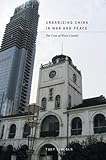Urbanizing China in War and Peace : The Case of Wuxi County / Toby Lincoln.
Material type: TextPublisher: Honolulu : University of Hawaii Press, [2015]Copyright date: ©2015Description: 1 online resource (288 p.) : 8 mapsContent type:
TextPublisher: Honolulu : University of Hawaii Press, [2015]Copyright date: ©2015Description: 1 online resource (288 p.) : 8 mapsContent type: - 9780824841003
- 9780824854195
- 307.760951/136 23
- online - DeGruyter
- Issued also in print.
| Item type | Current library | Call number | URL | Status | Notes | Barcode | |
|---|---|---|---|---|---|---|---|
 eBook
eBook
|
Biblioteca "Angelicum" Pont. Univ. S.Tommaso d'Aquino Nuvola online | online - DeGruyter (Browse shelf(Opens below)) | Online access | Not for loan (Accesso limitato) | Accesso per gli utenti autorizzati / Access for authorized users | (dgr)9780824854195 |
Browsing Biblioteca "Angelicum" Pont. Univ. S.Tommaso d'Aquino shelves, Shelving location: Nuvola online Close shelf browser (Hides shelf browser)

|

|

|

|

|

|

|
||
| online - DeGruyter Fragrant Orchid : The Story of My Early Life / | online - DeGruyter From King Cane to the Last Sugar Mill : Agricultural Technology and the Making of Hawaii's Premier Crop / | online - DeGruyter Marathon Japan : Distance Racing and Civic Culture / | online - DeGruyter Urbanizing China in War and Peace : The Case of Wuxi County / | online - DeGruyter A Handbook of Korean Zen Practice : A Mirror on the Sŏn School of Buddhism (Sŏn'ga kwigam) / | online - DeGruyter Zhuangzi and the Happy Fish / | online - DeGruyter Conceiving the Indian Buddhist Patriarchs in China / |
Frontmatter -- Contents -- Acknowledgments -- Weights and Measures -- Introduction -- Chapter One. The "Little Shanghai": Urbanization of Wuxi City -- Chapter Two. Wuxi Elites and Infrastructure: Urbanization of the Countryside -- Chapter Three. Local Elites and the State: Managing Wuxi during the Warlord Era -- Chapter Four. Abolish the County to Establish the City (Fei xian wei shi) -- Chapter Five. The Nationalist State and Rural Infrastructure -- Chapter Six. A Connected City: Native Place Societies, Migration, and Disaster Relief -- Chapter Seven. Threads of Silk: Economic Recovery in Occupied Wuxi -- Chapter Eight. The Utility of Rubble: Rebuilding the City and the Countryside -- Chapter Nine. A Militarized Environment: Japanese Impact on Daily Life -- Conclusion -- Character List -- Notes -- Bibliography -- Index
restricted access online access with authorization star
http://purl.org/coar/access_right/c_16ec
Urbanizing China in War and Peace rewrites the history of rural-urban relations in the first half of the twentieth century by arguing that urbanization is a total societal transformation and as important a factor as revolution, nationalism, or modernity in the history of modern China. Linking the global and the local in space and time, China's urbanization was not only driven by industrial capitalism and the expansion of the state, but also shaped how these forces influenced daily life in the city and the countryside. Although the conflict that beset China after the Japanese invasion in 1937 affected the development of cities, towns, and villages, it did not derail previous changes. To truly understand how China has emerged as the world's largest urban society, we must consider such continuities across the first half of the twentieth century-during periods of war as well as peace.The book focuses on Wuxi, a city that lies a hundred miles to the west of Shanghai. In the early twentieth century local industrialists were responsible for it quickly becoming the largest industrial city in China outside treaty ports. They built factories, roads, and other infrastructure outside the old city walls and in surrounding towns and villages. Chapters examine the county's transformation as recorded in guidebooks and travel magazines of the time and the role of the state in the early 1920s and into the Nanjing Decade, when new administrative laws led to the continued expansion of the city under both municipal and county officials. They explore the revival of the silk industry during the Japanese occupation and the industry's role in driving urbanization, as well as efforts by Chinese leaders to carry out prewar development plans despite lockdowns and qingxiang (clean the countryside) campaigns. In the midst of the barbed wire and watch towers, plans to shape the built environment in Wuxi County and the region as a whole persisted and were carried out.Ambitious and well researched, Urbanizing China in War and Peace will appeal to scholars and students of Chinese urban history, the Anti-Japanese War of Resistance, and the Republican period. Its engagement with issues of urbanization in general will interest urban historians of other times and places.
Issued also in print.
Mode of access: Internet via World Wide Web.
In English.
Description based on online resource; title from PDF title page (publisher's Web site, viewed 02. Mrz 2022)


